Facile Synthesis of Sustainable Biomass-Derived Porous Biochars as Promising Electrode Materials for High-Performance Supercapacitor Applications
Abstract
1. Introduction
2. Materials and Methods
2.1. Chemicals and Reagents
2.2. Preparation Process
2.2.1. Biochar Characterization
2.2.2. Preparation of Powder and Assembly of Two-Electrode Supercapacitors
3. Results and Discussion
3.1. Textural Properties and Morphology of the Biochars
3.2. Chemical and Functional Characterization of the Biochars
3.3. Electrochemical Characterization
- (i)
- The measured residual zinc in samples of ZnCl2 Biochar, even at a small quantity, might influence the capacitance of the electrodes since Zn metal has a high theoretical capacity (820 mAh g−1) [51], which is more than double the theoretical capacity of graphite (372 mAh g−1);
- (ii)
- The morphology of ZnCl2-based biochars with a rich distribution of cavities and holes are driven forces that facilitate the permeation of electrolytes along with the electrodes, contributing to a more effective process of charge separation.
4. Conclusions
Author Contributions
Funding
Institutional Review Board Statement
Informed Consent Statement
Data Availability Statement
Conflicts of Interest
References
- Finon, D.; Perez, Y.; Finon, D.; Perez, Y. The social efficiency of instruments of promotion of renewable energies: A transaction-cost perspective. Ecol. Econ. 2007, 62, 77–92. [Google Scholar] [CrossRef]
- Dos Reis, G.S.; Larsson, S.H.; de Oliveira, H.P.; Thyrel, M.; Lima, E.C. Sustainable biomass activated carbons as electrodes for battery and supercapacitors—A mini-review. Nanomaterials 2020, 10, 1398. [Google Scholar] [CrossRef] [PubMed]
- Dos Reis, G.S.; de Oliveira, H.P.; Larsson, S.H.; Thyrel, M.; Lima, E.C. A short review on the electrochemical performance of hierarchical and nitrogen-doped activated biocarbon-based electrodes for supercapacitors. Nanomaterials 2021, 11, 424. [Google Scholar] [CrossRef] [PubMed]
- Jalal, N.I.; Ibrahim, R.I.; Oudah, M.K. A review on Supercapacitors: Types and components. J. Phys. Conf. Ser. 2021, 1973, 012015. [Google Scholar] [CrossRef]
- Saikia, B.K.; Benoy, S.M.; Bora, M.; Tamuly, J.; Pandey, M.; Bhattacharya, D. A brief review on supercapacitor energy storage devices and utilization of natural carbon resources as their electrode materials. Fuel 2020, 282, 118796. [Google Scholar] [CrossRef]
- Zhang, W.; Cheng, R.R.; Bi, H.H.; Lu, Y.H.; Ma, L.B.; He, X.J. A review of porous carbons produced by template methods for supercapacitor applications. New Carbon Mater. 2021, 36, 69–81. [Google Scholar] [CrossRef]
- Yang, Z.; Tian, J.; Yin, Z.; Cui, C.; Qian, W.; Wei, F. Carbon nanotube- and graphene-based nanomaterials and applications in high-voltage supercapacitor: A review. Carbon N. Y. 2019, 141, 467–480. [Google Scholar] [CrossRef]
- Lima, R.M.A.P.; de Oliveira, M.C.A.; de Oliveira, H.P. Wearable supercapacitors based on graphene nanoplatelets/carbon nanotubes/polypyrrole composites on cotton yarns electrodes. SN Appl. Sci. 2019, 1, 325. [Google Scholar] [CrossRef]
- De Oliveira, H.P.; Sydlik, S.A.; Swager, T.M. Supercapacitors from free-standing polypyrrole/graphene nanocomposites. J. Phys. Chem. C 2013, 117, 10270–10276. [Google Scholar] [CrossRef]
- Frackowiak, E.; Béguin, F. Carbon materials for the electrochemical storage of energy in capacitors. Carbon 2001, 39, 937–950. [Google Scholar] [CrossRef]
- Lei, Z.; Zhang, J.; Zhang, L.L.; Kumar, N.A.; Zhao, X.S. Functionalization of chemically derived graphene for improving its electrocapacitive energy storage properties. Energy Environ. Sci. 2016, 9, 1891–1930. [Google Scholar] [CrossRef]
- Hou, J.; Jiang, K.; Tahir, M.; Wu, X.; Idrees, F.; Shen, M.; Cao, C. Tunable porous structure of carbon nanosheets derived from puffed rice for high energy density supercapacitors. J. Power Sources 2017, 371, 148–155. [Google Scholar] [CrossRef]
- Xie, K.; Hu, Y.; Afonaa-Mensah, S.; Yuan, C.; Cao, B.; Wang, S.; Wang, Q. Study on the preparation of nitrogen-doped hierarchically porous and high-performance carbon materials from seaweed biomass. J. Renew. Mater. 2022, 10, 541–560. [Google Scholar] [CrossRef]
- Dos Reis, G.S.; Pinheiro Lima, R.M.A.; Larsson, S.H.; Subramaniyam, C.M.; Dinh, V.M.; Thyrel, M.; de Oliveira, H.P. Flexible supercapacitors of biomass-based activated carbon-polypyrrole on eggshell membranes. J. Environ. Chem. Eng. 2021, 9, 106155. [Google Scholar] [CrossRef]
- Duan, D.; Chen, D.; Huang, L.; Zhang, Y.; Zhang, Y.; Wang, Q.; Xiao, G.; Zhang, W.; Lei, H.; Ruan, R. Activated carbon from lignocellulosic biomass as catalyst: A review of the applications in fast pyrolysis process. J. Anal. Appl. Pyrolysis 2021, 158, 105246. [Google Scholar] [CrossRef]
- Dos Reis, G.S.; Larsson, S.H.; Mathieu, M.; Thyrel, M.; Pham, T.N. Application of design of experiments (DoE) for optimised production of micro- and mesoporous Norway spruce bark activated carbons. Biomass Convers. Biorefinery 2021. [Google Scholar] [CrossRef]
- Molina-Sabio, M.; Rodríguez-Reinoso, F. Role of chemical activation in the development of carbon porosity. Colloids Surf. A Physicochem. Eng. Asp. 2004, 241, 15–25. [Google Scholar] [CrossRef]
- Jiang, C.; Yakaboylu, G.A.; Yumak, T.; Zondlo, J.W.; Sabolsky, E.M.; Wang, J. Activated carbons prepared by indirect and direct CO2 activation of lignocellulosic biomass for supercapacitor electrodes. Renew. Energy 2020, 155, 38–52. [Google Scholar] [CrossRef]
- He, X.; Ling, P.; Qiu, J.; Yu, M.; Zhang, X.; Yu, C.; Zheng, M. Efficient preparation of biomass-based mesoporous carbons for supercapacitors with both high energy density and high power density. J. Power Sources 2013, 240, 109–113. [Google Scholar] [CrossRef]
- Wu, C.; Yang, S.; Cai, J.; Zhang, Q.; Zhu, Y.; Zhang, K. Activated Microporous Carbon Derived from Almond Shells for High Energy Density Asymmetric Supercapacitors. ACS Appl. Mater. Interfaces 2016, 8, 15288–15296. [Google Scholar] [CrossRef] [PubMed]
- Dos Reis, G.S.; Larsson, S.H.; Thyrel, M.; Pham, T.N.; Lima, E.C.; de Oliveira, H.P.; Dotto, G.L. Preparation and Application of Efficient Biobased Carbon Adsorbents Prepared from Spruce Bark Residues for Efficient Removal of Reactive Dyes and Colors from Synthetic Effluents. Coatings 2021, 11, 772. [Google Scholar] [CrossRef]
- Lima, D.R.; Lima, E.C.; Thue, P.S.; Dias, S.L.P.; Machado, F.M.; Seliem, M.K.; Sher, F.; dos Reis, G.S.; Saeb, M.R.; Rinklebe, J. Comparison of acidic leaching using a conventional and ultrasound-assisted method for preparation of magnetic-activated biochar. J. Environ. Chem. Eng. 2021, 9, 105865. [Google Scholar] [CrossRef]
- Donohue, M.D.; Aranovich, G.L. Classification of Gibbs adsorption isotherms. Adv. Colloid Interface Sci. 1998, 76–77, 137–152. [Google Scholar] [CrossRef]
- Dos Reis, G.S.; Lima, E.C.; Sampaio, C.H.; Rodembusch, F.S.; Petter, C.O.; Cazacliu, B.G.; Dotto, G.L.; Hidalgo, G.E.N. Novel kaolin/polysiloxane based organic-inorganic hybrid materials: Sol-gel synthesis, characterization and photocatalytic properties. J. Solid State Chem. 2018, 260, 106–116. [Google Scholar] [CrossRef]
- Luo, Q.P.; Huang, L.; Gao, X.; Cheng, Y.; Yao, B.; Hu, Z.; Wan, J.; Xiao, X.; Zhou, J. Activated carbon derived from melaleuca barks for outstanding high-rate supercapacitors. Nanotechnology 2015, 26, 304004. [Google Scholar] [CrossRef] [PubMed]
- Wang, J.; Kaskel, S. KOH activation of carbon-based materials for energy storage. J. Mater. Chem. 2012, 45, 23710. [Google Scholar] [CrossRef]
- Ma, Y. Comparison of Activated Carbons Prepared from Wheat Straw via ZnCl2 and KOH Activation. Waste Biomass Valorization 2017, 8, 549–559. [Google Scholar] [CrossRef]
- Khelfa, A.; Finqueneisel, G.; Auber, M.; Weber, J.V. Influence of some minerals on the cellulose thermal degradation mechanisms: Thermogravimetric and pyrolysis-mass spectrometry studies. J. Therm. Anal. Calorim. 2018, 92, 795–799. [Google Scholar] [CrossRef]
- Domvoglou, D.; Ibbett, R.; Wortmann, F.; Taylor, J. Controlled thermo-catalytic modification of regenerated cellulosic fibres using magnesium chloride Lewis acid. Cellulose 2009, 16, 1075–1087. [Google Scholar] [CrossRef]
- Miao, L.; Duan, H.; Wang, Z.; Lv, Y.; Xiong, W.; Zhu, D.; Gan, L.; Li, L.; Liu, M. Improving the pore-ion size compatibility between poly(ionic liquid)-derived carbons and high-voltage electrolytes for high energy-power supercapacitors. Chem. Eng. J. 2020, 382, 122945. [Google Scholar] [CrossRef]
- Qin, T.T.; Shi, Z.Q.; Li, M.W.; Wang, C.Y. Effect of reduction heat treatment in H2 atmosphere on structure and electrochemical properties of activated carbon. J. Solid State Electrochem. 2015, 19, 1437–1446. [Google Scholar] [CrossRef]
- Hu, Y.; Tong, X.; Zhuo, H.; Zhong, L.; Peng, X.; Wang, S.; Sun, R. 3D hierarchical porous N-doped carbon aerogel from renewable cellulose: An attractive carbon for high-performance supercapacitor electrodes and CO2 adsorption. RSC Adv. 2016, 6, 15788–15795. [Google Scholar] [CrossRef]
- Hou, S.; Cai, X.; Wu, H.; Yu, X.; Peng, M.; Yan, K.; Zou, D. Nitrogen-doped graphene for dye-sensitized solar cells and the role of nitrogen states in triiodide reduction. Energy Environ. Sci. 2013, 6, 3356–3362. [Google Scholar] [CrossRef]
- Huang, G.G.; Liu, Y.F.; Wu, X.X.; Cai, J.J. Activated carbons prepared by the KOH activation of a hydrochar from garlic peel and their CO2 adsorption performance. New Carbon Mater. 2019, 34, 247–257. [Google Scholar] [CrossRef]
- Sun, L.; Tian, C.; Li, M.; Meng, X.; Wang, L.; Wang, R.; Yin, J.; Fu, H. From coconut shell to porous graphene-like nanosheets for high-power supercapacitors. J. Mater. Chem. A 2013, 1, 6462–6470. [Google Scholar] [CrossRef]
- Zhan, Y.; Zhou, H.; Guo, F.; Tian, B.; Du, S.; Dong, Y.; Qian, Y. Preparation of highly porous activated carbons from peanut shells as low-cost electrode materials for supercapacitors. J. Energy Storage 2021, 34, 102180. [Google Scholar] [CrossRef]
- Bello, A.; Fashedemi, O.O.; Barzegar, F.; Madito, M.J.; Momodu, D.Y.; Masikhwa, T.M.; Dangbegnon, J.K.; Manyala, N. Microwave synthesis: Characterization and electrochemical properties of amorphous activated carbon-MnO2 nanocomposite electrodes. J. Alloy. Compd. 2016, 681, 293–300. [Google Scholar] [CrossRef]
- NeivaI, D.M.; Araujo, S.; Gominho, J. Angelica de Cassia Carneiro, Helena Pereira, An integrated characterization of Picea abies industrial bark regarding chemical composition, thermal properties and polar extracts activity. PLoS ONE 2018, 13, e0208270. [Google Scholar]
- Itagaki, M.; Suzuki, S.; Shitanda, I.; Watanabe, K. Electrochemical impedance and complex capacitance to interpret electrochemical capacitor. Electrochemistry 2007, 75, 649–655. [Google Scholar] [CrossRef]
- Kumar, D.; Banerjee, A.; Patil, S.; Shukla, A.K. A 1 V supercapacitor device with nanostructured graphene oxide/polyaniline composite materials. Bull. Mater. Sci. 2015, 38, 1507–1517. [Google Scholar] [CrossRef]
- Liu, W.J.; Jiang, H.; Yu, H.Q. Emerging applications of biochar-based materials for energy storage and conversion. Energy Environ. Sci. 2019, 12, 1751–1779. [Google Scholar] [CrossRef]
- Denmark, I.; Macchi, S.; Watanabe, F.; Viswanathan, T.; Siraj, N. Effect of KOH on the Energy Storage Performance of Molasses-Based Phosphorus and Nitrogen Co-Doped Carbon. Electrochem 2021, 2, 29–41. [Google Scholar] [CrossRef]
- Gou, G.; Huang, F.; Jiang, M.; Li, J.; Zhou, Z. Hierarchical porous carbon electrode materials for supercapacitor developed from wheat straw cellulosic foam. Renew. Energy 2020, 149, 208–216. [Google Scholar] [CrossRef]
- Huang, T.; Zheng, B.; Kou, L.; Gopalsamy, K.; Xu, Z.; Gao, C.; Meng, Y.; Wei, Z. Flexible high performance wet-spun graphene fiber supercapacitors. RSC Adv. 2013, 3, 23957–23962. [Google Scholar] [CrossRef]
- Li, B.; Cheng, J.; Wang, Z.; Li, Y.; Ni, W.; Wang, B. Highly-wrinkled reduced graphene oxide-conductive polymer fibers for flexible fiber-shaped and interdigital-designed supercapacitors. J. Power Sources 2018, 376, 117–124. [Google Scholar] [CrossRef]
- Zhang, M.; Wang, X.; Yang, T.; Zhang, P.; Wei, X.; Zhang, L.; Li, H. Polyaniline/graphene hybrid fibers as electrodes for flexible supercapacitors. Synth. Met. 2020, 268, 116484. [Google Scholar] [CrossRef]
- He, D.; Wu, L.; Yao, Y.; Zhang, J.; Huang, Z.H.; Wang, M.X. A facile route to high nitrogen-containing porous carbon fiber sheets from biomass-flax for high-performance flexible supercapacitors. Appl. Surf. Sci. 2020, 507, 145108. [Google Scholar] [CrossRef]
- Wang, S.; Yu, Y.; Luo, S.; Cheng, X.; Feng, G.; Zhang, Y.; Wu, Z.; Compagnini, G.; Pooran, J.; Hu, A. All-solid-state supercapacitors from natural lignin-based composite film by laser direct writing. Appl. Phys. Lett. 2019, 115, 083904. [Google Scholar] [CrossRef]
- Yi, J.; Qing, Y.; Wu, C.T.; Zeng, Y.; Wu, Y.; Lu, X.; Tong, Y. Lignocellulose-derived porous phosphorus-doped carbon as advanced electrode for supercapacitors. J. Power Sources 2017, 351, 130–137. [Google Scholar] [CrossRef]
- Shi, J.; Jiang, B.; Li, C.; Liu, Z.; Yan, F.; Liu, X.; Li, H.; Yang, C.; Dong, D.; Hao, J. Study on capacitance properties of the sputtered carbon doped titanium nitride electrode material for supercapacitor. Vacuum 2022, 198, 110893. [Google Scholar] [CrossRef]
- Wang, L.P.; Li, N.W.; Wang, T.S.; Yin, Y.X.; Guo, Y.G.; Wang, C.R. Conductive graphite fiber as a stable host for zinc metal anodes. Electrochim. Acta 2017, 244, 172–177. [Google Scholar] [CrossRef]
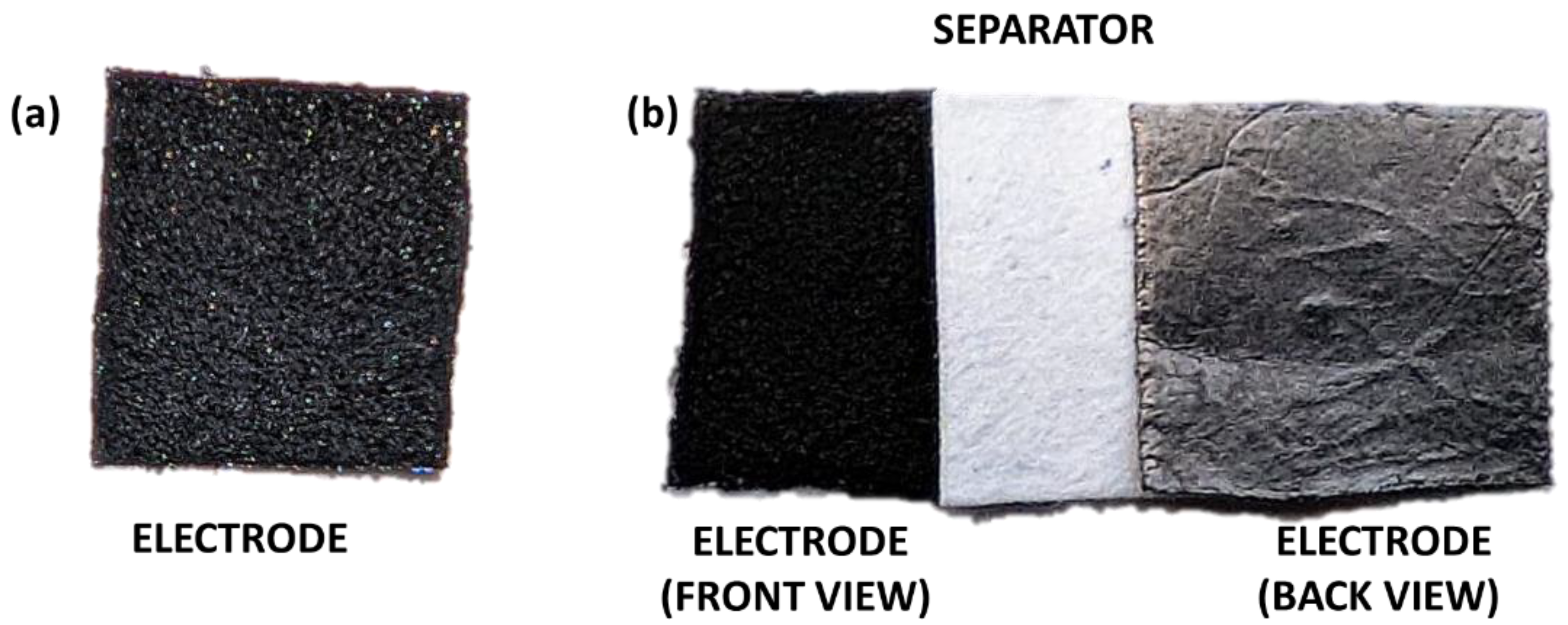
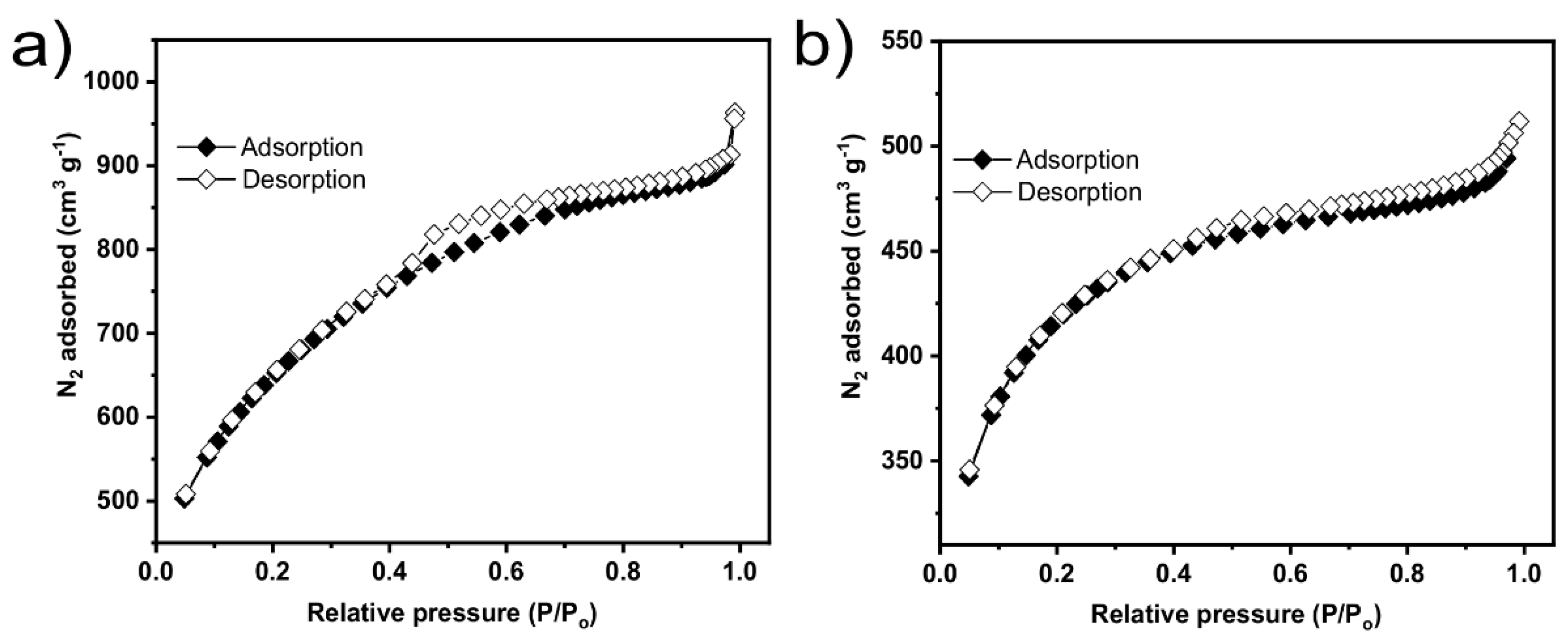
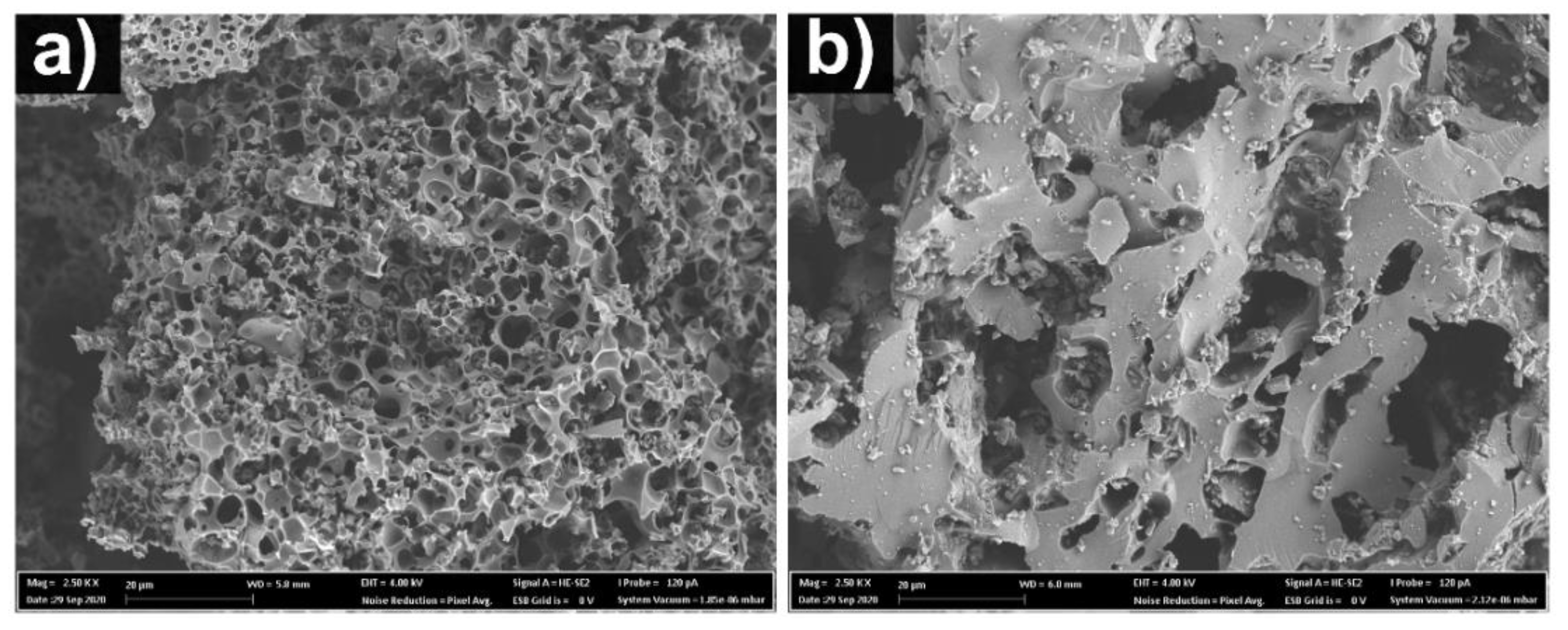



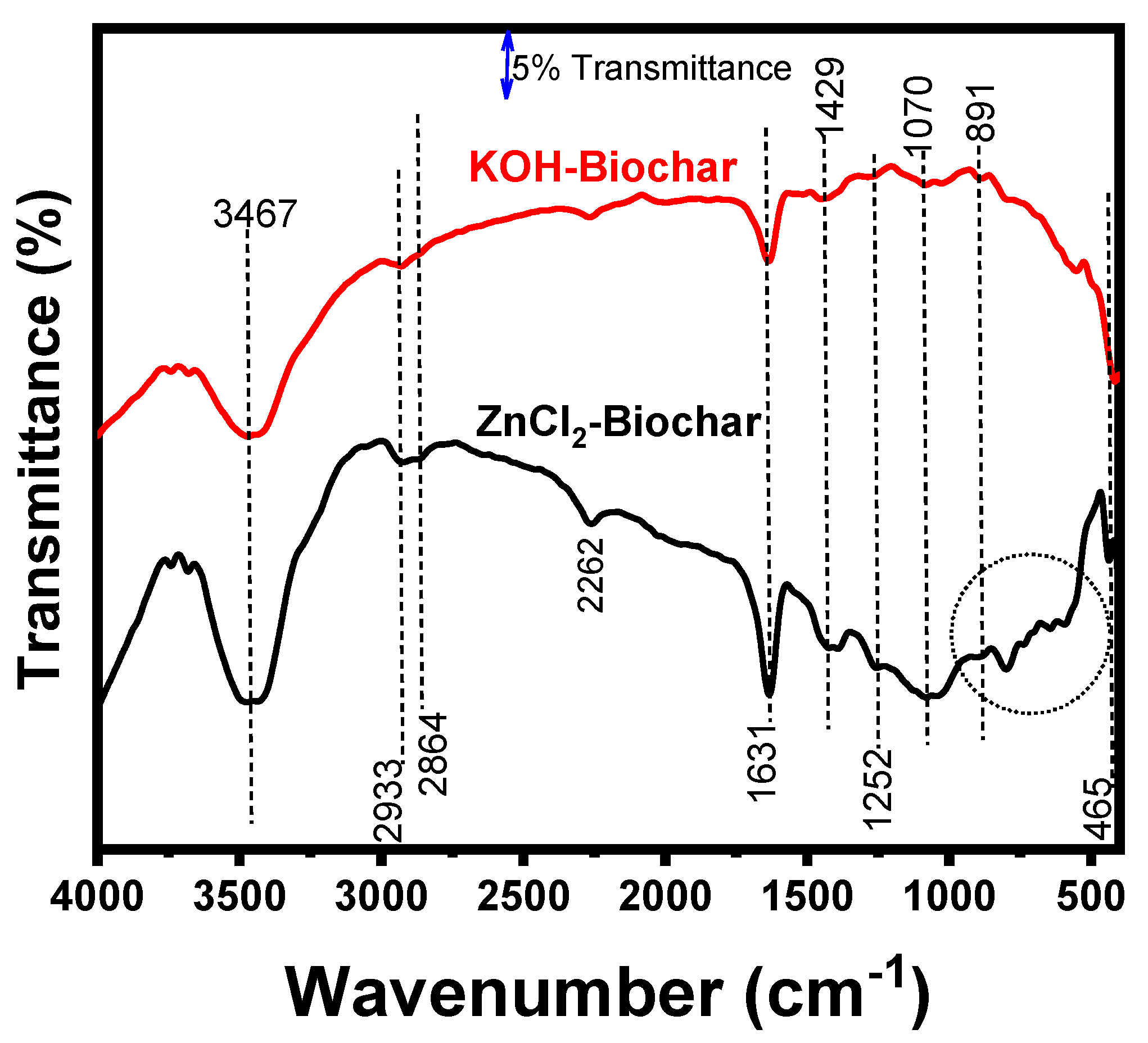
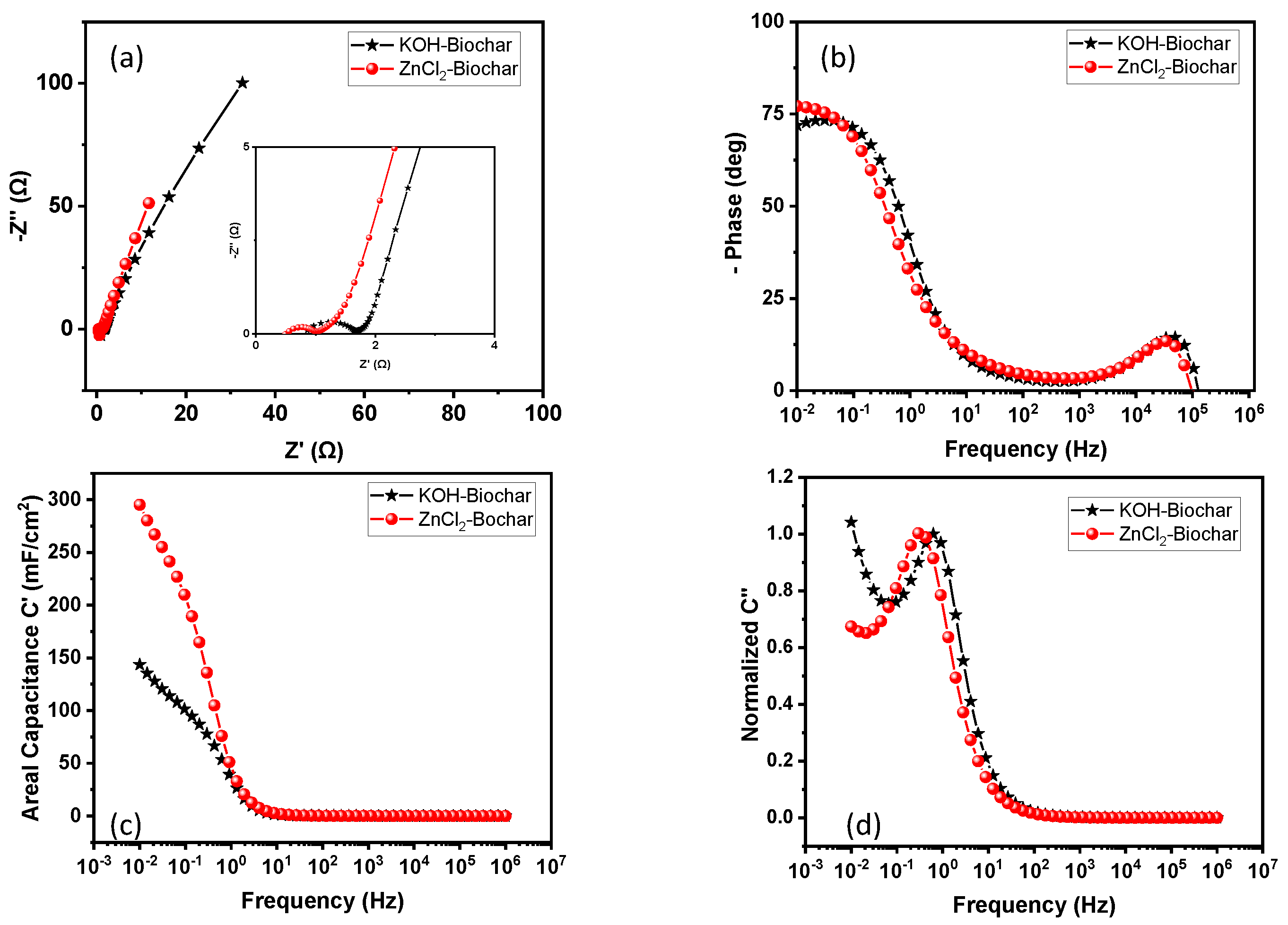
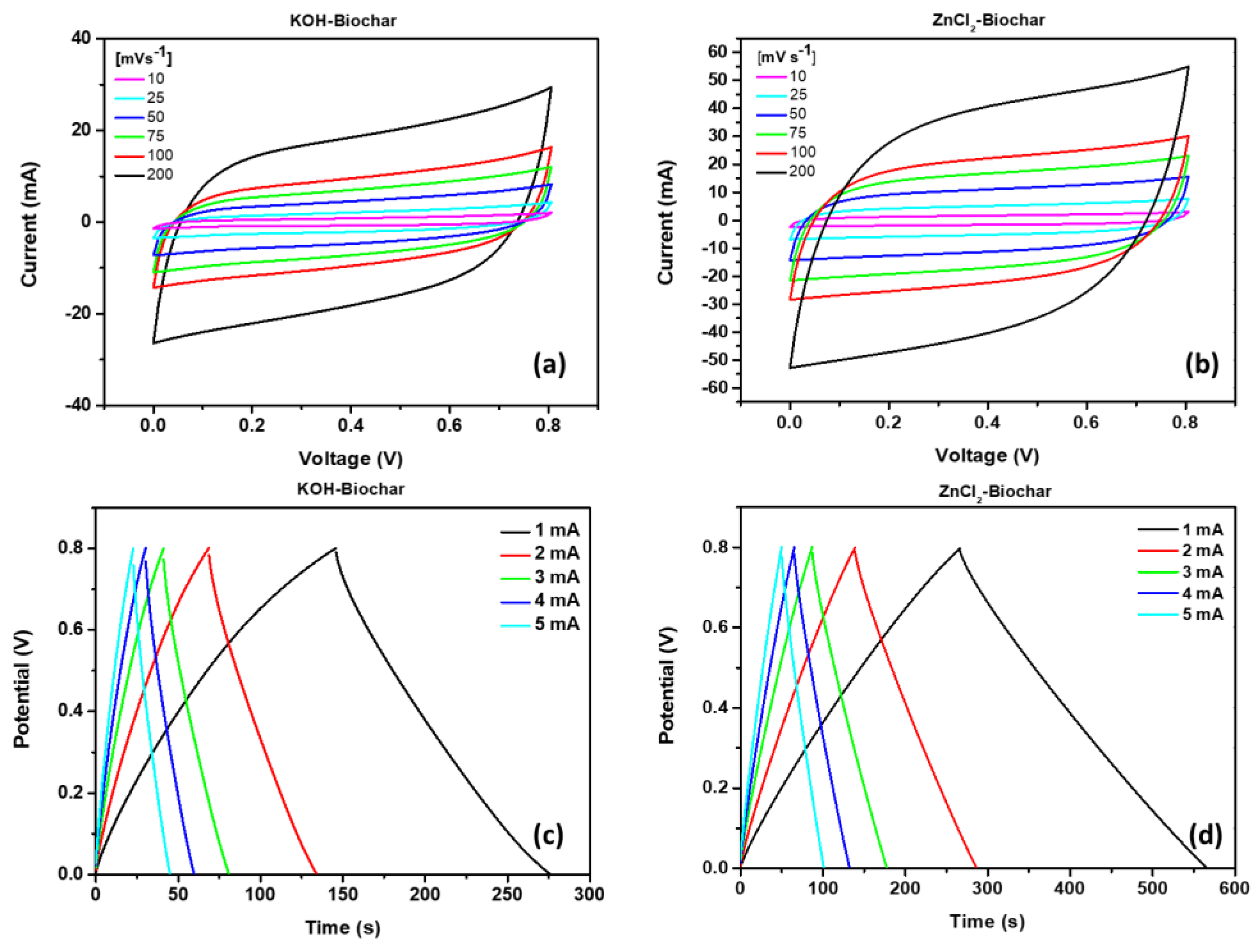
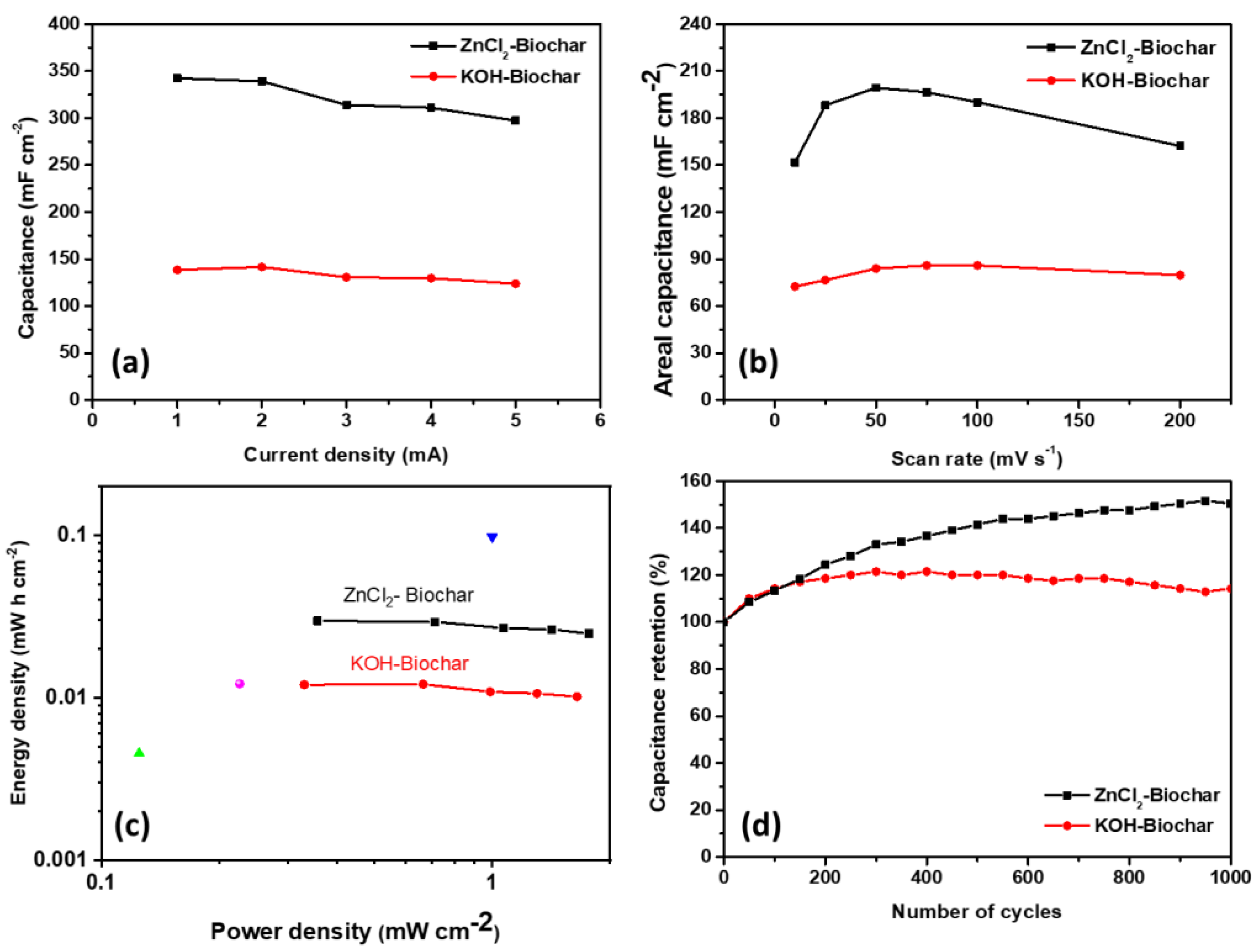
| Parameters. | ZnCl2 Biochar | KOH Biochar |
|---|---|---|
| SSA (m2 g−1) | 1018 | 2209 |
| Mesopore surface area (m2 g−1) | 456 | 449 |
| Mesopore surface area (%) | 46.0 | 22.6 |
| Micropore area (m2 g−1) | 562 | 1710 |
| Micropore area (%) | 54.0 | 77.4 |
| Total pore volume (cm3 g−1) | 0.78 | 1.50 |
| Micropore volume (cm3 g−1) | 0.41 | 0.25 |
| Mesopore volume (cm3 g−1) | 0.37 | 1.25 |
| Average pore size (nm) | 2.21 | 2.70 |
| XPS | ID/IG | HI | ||||
|---|---|---|---|---|---|---|
| Samples | C 1s | O 1s | N 1s | Zn 2p | ||
| ZnCl2 biochar | 93.3 | 4.7 | 1.5 | 0.5 | 0.94 | 0.90 |
| KOH biochar | 86.6 | 10.5 | 1.7 | - | 1.16 | 0.96 |
| Electrode Material (Red for Biochar-Based Materials) | Areal Capacitance | Electrolyte | Current Density (A g−1) or Scan Rate (mV s−1) | Reference |
|---|---|---|---|---|
| Wheat straw cellulosic biochar | 0.3 mF cm−2 | 6 M KOH | 0.5 A g−1 | [43] |
| Graphene fiber | 3.3 mF cm−2 | PVA/H3PO4 | [44] | |
| Modified Graphene fiber with polyaniline | 66.6 mF cm−2 | PVA/H3PO4 | [44] | |
| Graphene oxide-conductive polymer fiber | 131 mF cm−2 | PVA/H3PO4 | [45] | |
| Graphene modified with polyaniline | 87.8 mF cm−2 | EMITFSI/PVDF-HFP | 0.22 mA cm−2 | [46] |
| N-doped porous carbon fiber sheets from biomass-flax | 703 mF cm−2 | 6 M KOH | 20 mA cm−2 | [47] |
| Lignin-carbon decorated with molybdenum disulfide | 16 mF cm−2 | 6 M KOH | 10 mV s−1 | [48] |
| Lignocellulose-derived phosphorus-doped carbon | 146 mF cm−2 | 6 M KOH | 10 A g−1 | [49] |
| Sputtered carbon-doped titanium nitride | 45.81 mF cm−2 | 6 M KOH | 10 mV s−1 | [50] |
| KOH biochar | 138.49 mF cm−2 | 5 M KOH | 5 A g−1 | This work |
| ZnCl2 biochar | 342 mF cm−2 | 5 M KOH | 5 A g−1 | This work |
Publisher’s Note: MDPI stays neutral with regard to jurisdictional claims in published maps and institutional affiliations. |
© 2022 by the authors. Licensee MDPI, Basel, Switzerland. This article is an open access article distributed under the terms and conditions of the Creative Commons Attribution (CC BY) license (https://creativecommons.org/licenses/by/4.0/).
Share and Cite
Lima, R.M.A.P.; dos Reis, G.S.; Thyrel, M.; Alcaraz-Espinoza, J.J.; Larsson, S.H.; de Oliveira, H.P. Facile Synthesis of Sustainable Biomass-Derived Porous Biochars as Promising Electrode Materials for High-Performance Supercapacitor Applications. Nanomaterials 2022, 12, 866. https://doi.org/10.3390/nano12050866
Lima RMAP, dos Reis GS, Thyrel M, Alcaraz-Espinoza JJ, Larsson SH, de Oliveira HP. Facile Synthesis of Sustainable Biomass-Derived Porous Biochars as Promising Electrode Materials for High-Performance Supercapacitor Applications. Nanomaterials. 2022; 12(5):866. https://doi.org/10.3390/nano12050866
Chicago/Turabian StyleLima, Ravi Moreno Araujo Pinheiro, Glaydson Simões dos Reis, Mikael Thyrel, Jose Jarib Alcaraz-Espinoza, Sylvia H. Larsson, and Helinando Pequeno de Oliveira. 2022. "Facile Synthesis of Sustainable Biomass-Derived Porous Biochars as Promising Electrode Materials for High-Performance Supercapacitor Applications" Nanomaterials 12, no. 5: 866. https://doi.org/10.3390/nano12050866
APA StyleLima, R. M. A. P., dos Reis, G. S., Thyrel, M., Alcaraz-Espinoza, J. J., Larsson, S. H., & de Oliveira, H. P. (2022). Facile Synthesis of Sustainable Biomass-Derived Porous Biochars as Promising Electrode Materials for High-Performance Supercapacitor Applications. Nanomaterials, 12(5), 866. https://doi.org/10.3390/nano12050866








